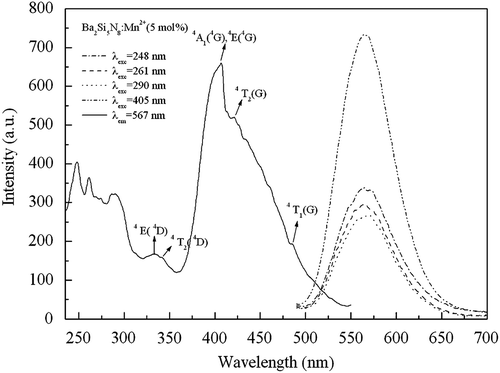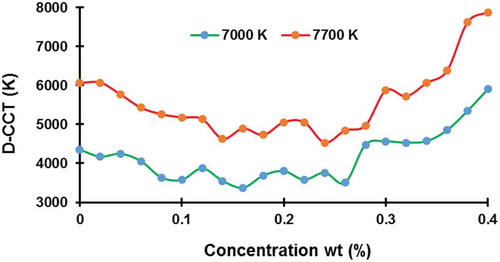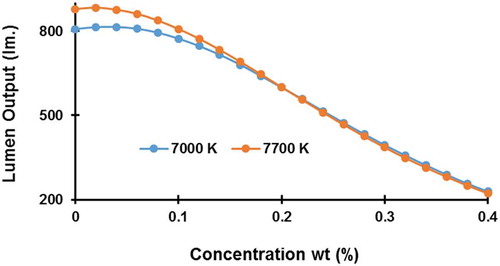 ?Mathematical formulae have been encoded as MathML and are displayed in this HTML version using MathJax in order to improve their display. Uncheck the box to turn MathJax off. This feature requires Javascript. Click on a formula to zoom.
?Mathematical formulae have been encoded as MathML and are displayed in this HTML version using MathJax in order to improve their display. Uncheck the box to turn MathJax off. This feature requires Javascript. Click on a formula to zoom.Abstract
In this research, the influence of the red-emitting Ba2Si5N8Eu2+ convention phosphor on the optical performance of the 7,000 K and 7,700 K in-cup packaging multi-chip white LEDs (MCW-LEDs) is investigated. The effect of the red-emitting Ba2Si5N8Eu2+ convention phosphor is demonstrated based on Mie Theory by Mat Lab and Light Tools software. The research results indicated that the optical performance of MCW-LEDs was crucially affected by the red-emitting Ba2Si5N8Eu2+ phosphor’s concentration. This paper provides an essential recommendation for selecting and developing the phosphor materials for MW-LEDs manufacturing.
PUBLIC INTEREST STATEMENT
Light-emitting diodes (LEDs) have found their way into many applications in daily life, from warm-white LEDs for energy-efficient lighting to display backlights for smartphones, tablets, and televisions. The current attention to energy-saving and reduction of CO2 emission in the atmosphere should, therefore, give an additional boost to the development of LEDs for lighting. In this research, we investigated the influence of the red-emitting Ba2Si5N8Eu2+ conversion phosphor on the color quality of the 7,000 K, and 7,700 K in-cup packaging multi-chip white LEDs (MCW-LEDs). The research results indicated that the lighting performance of MCW-LEDs was crucially affected by the red-emitting Ba2Si5N8Eu2+ conversion phosphor’s size. This research demonstrated a significant recommendation for selecting and developing the phosphor materials for MCW-LEDs manufacturing.
1. Introduction
Light-emitting diodes (LEDs) are the modest type of solid-state lighting, which have the most significant advancement in the lighting industry in the last few decades. Phosphor-converted LEDs (pcLED), which combine a blue LED chip, and the yellow emitting phosphor is the most common approach to accomplish white light emission through LEDs packaging (“Design of LED,” Citation2011; Gibney, Citation2014; Hu, Luo, & Liu, Citation2011; Luo, Hu, Liu, & Wang, Citation2016; Winkler, Trinh, Bodrogi, & Khanh, Citation2015). In the last few decades, there so many research focuses on improving the optical performance of the pcLED in packaging direction. Thickness and concentration of phosphor are considered as the main factors in the white LEDs packaging because the luminous flux and color of LEDs are adjusted mainly through changing the phosphor thickness and concentration after the phosphor converters are chosen. Shuai, He, Tran, and Shi (Citation2011) and Tran and Shi (Citation2008) experimentally studied the effects of phosphor thickness and concentration on LEDs luminous flux and correlated color temperature. From the results, higher luminous efficacy are taken with the lower phosphor concentration and higher phosphor thickness (lower trapping efficiency and fewer backs scattering of light). Sommer et al. firstly studied the effects of phosphor thickness, concentration, and size on the spatial color distribution of white LEDs (Sommer et al., Citation2008). The spatial color uniformity of white LEDs could be improved by changing the phosphor concentration or thickness. An increase of the phosphor thickness or concentration can alter the color from bluish to yellowish, and the growth in the central zone is faster than that in the border area. In Li et al. (Citation2012) and Liu, Liu, Wang, and Luo (Citation2008a, Citation2008b, Citation2008c), the effect of phosphor location on the spatial color distribution was investigated. The results showed that to obtain high color uniformity packaging elements should make the blue light and yellow light have a similar radiation pattern. In the last year, some researchers were concentrated on enhancing the optical performance of multi-chip white LEDs (MCW-LEDs) by adding green or red phosphor into the phosphor compounding (Anh, Quoc, & Lee, Citation2016; Minh, Quang, Nhan, Anh, & Lee, Citation2017). It can be found that the optical properties of MCW-LEDs can be enhanced clearly. From this point of view, improving the optical performance of MCW-LEDs by adding diffusers into the phosphor compounding is still needed to be investigated. In this research, we try to fill the remaining gap.
In this research, the red-emitting Ba2Si5N8Eu2+ phosphor is proposed to enhancing the optical performance of the 7,000 K and 7,700 K in-cup packaging MCW-LEDs. The optical performance of the MCW-LEDs is based on the primary factors like the color uniformity or the correlated color temperature deviation (D-CCT), the color rendering index (CRI), the color quality scale (CQS), and the luminous efficacy (lumen output). This paper is divided into three sections. The physical model of the 7,000 K, 7,700 K in-cup packaging MCW-LEDs and the optical properties of the red-emitting Ba2Si5N8Eu2+ conversion phosphor are presented Section 1. In Section 2, the mathematical optical description based on Mie theory of red-emitting Ba2Si5N8Eu2+ phosphor with Mat lab software and the simulation results with the commercial Light Tools software (Synopsys) is collected. Finally, the research results are intensely discussed, analyzed, and investigated in Section 3. Then, some conclusions are proposed. From the research results, we can conclude that the red-emitting Ba2Si5N8Eu2+ phosphor crucial influenced the optical performance of the 7,000 K and 7,700 K in-cup packaging MCW-LEDs. The red-emitting Ba2Si5N8Eu2+ phosphor could be considered as a prospective approach for MCW-LEDs improvement shortly.
2. Research method
2.1. The MCW-LEDs physical model
The simulations were carried out using the commercial software package Light Tools. The simulation comprises the set-up of the in-cup packaging MCW-LEDs with average CCT of 7,000 K and 7,700 K. Firstly, to guarantee that our simulation results reflect precisely the impact of our considered parameter (concentration of the red-emitting Ba2Si5N8Eu2+ phosphor) and are not biased by other factors such as LED’s wavelength, waveform, light intensity, and operating temperature, we use the real-world model of MCW-LEDs (Figure )). In this simulation stage, we set the main parameters of the in-cup MCW-LEDs as follows:
The depth, and the inner and outer radius of the reflector to 2.07, 8, and 9.85 mm, respectively.
Nine LED chips are covered with a fixed thickness of 0.08 and 2.07 mm. Each blue chip has a dimension of 1.14 mm × 0.15 mm, the radiant flux of 1.16 W, and the peak wavelength of 453 nm (Figure )).
Figure 1. (a) The MCW-LED product of the Siliconware Precision Industries Co., Ltd., Taiwan. (b) Illustration of MCW-LEDs with the in-cup phosphor packaging.
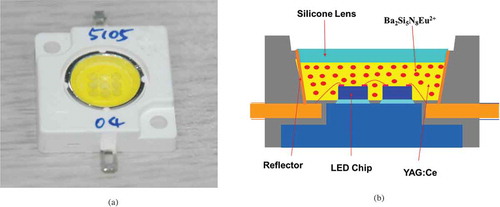
In this simulation, the phosphor layer consists of the yellow-emitting YAG:Ce and the red-emitting Ba2Si5N8Eu2+ conversion phosphors particles and the silicone glue, which respectively have the refractive indices of 1.85, 1.93, and 1.50 at room temperature (25°C). Also, the average radius of the yellow-emitting YAG:Ce phosphor particles is set to 7.25 µm for all packages, a value of real particle size. To make the color of MCW-LEDs produce the same when the concentration of the red-emitting Ba2Si5N8Eu2+ phosphor varies, the yellow-emitting YAG:Ce phosphor concentration should be inversely changed to provide same CCT value. The weight percentage of the MCW-LEDs phosphor layers can be expressed as
Here, W silicone, W Yellow phosphor, and W Red phosphor are in turn the weight percentage of the silicone glue, the yellow-emitting YAG:Ce phosphor, and the red-emitting CeTb phosphors (Anh et al., Citation2016, Citation2017; Minh et al., Citation2017).
2.2. The optical properties of the red-emitting phosphor
Recently, the compounds M2Si5N8 (M: Ca, Sr, Ba) have been intensively studied as host lattice in the exploration of LED conversion phosphors. Due to the high covalency and large crystal field effect of nitrogen anion, Ce3+ and Eu2+ show long wavelength emission in M2Si5N8 host lattice (M = Ca, Sr, Ba). These rare-earth doped materials have already been demonstrated to be promising conversion phosphors for the white-light LED application (Chen & Xie, Citation2014; Duan, Otten, Delsing, & Hintzen, Citation2008; Fukuda, Okada, & Albessard, Citation2012; Li, Xie, Hirosaki, Takeda, & Zhou, Citation2009; Li et al., Citation2006; Zeuner, Schmidt, & Schnick, Citation2009). Luminescence due to Mn2+ is known to occur in a lot of inorganic compounds. As for the application of Mn2+-doped phosphors in the field of white-light LED, many investigations have been done (Chen & Xie, Citation2014; Duan et al., Citation2008; Fukuda et al., Citation2012; Li et al., Citation2006, Citation2009; Zeuner et al., Citation2009). These phosphors efficiently emit visible light from yellow-green to red range. Also, compared with oxide and sulfide phosphors, they show superior thermal and chemical stability. Among these (oxy) nitride phosphors, M2Si5N8:Eu2+ (M: Ca, Sr, Ba) shows unusually long wavelength broadband emission between 570 and 680 nm depending on the type of the M ion and Eu2+ concentration under near-UV to blue light irradiation (370–465 nm) and has high quantum efficiency and very low thermal quenching, which makes it an encouraging yellow-red phosphor for white LEDs to improve the CRI (Figure ) (Chen & Xie, Citation2014; Duan et al., Citation2008; Fukuda et al., Citation2012; Li et al., Citation2006, Citation2009; Zeuner et al., Citation2009).
2.3. The mathematical description of the red-emitting phosphor
The influence of the concentration of the red-emitting Ba2Si5N8Eu2+ phosphor on the optical performance of the MCW-LEDs can be demonstrated using Mie theory (“Design of LED,” Citation2011; Winkler et al., Citation2015). Here, we can apply Mie-scattering theory (“Beyond Mie’s theory II,” Citation2011; Frisvad, Christensen, & Jensen, Citation2012; Mackowski, Citation2012; Wriedt, Citation2012). The scattering coefficient μ sca(λ) (mm−1), the absorption coefficient μ abs(λ) (mm−1), anisotropy factor g(λ) (mm−1), and reduced scattering coefficient δ sca(λ) (mm−1) can be computed by the following expressions (1)–(4):
In these equations, N(r) indicates the distribution density of diffusional particles (mm3). C abs and C sca are the absorption and scattering cross sections (mm2), p(θ,λ,r) is the phase function, λ is the light wavelength (nm), r is the radius of diffusional particles (µm), and θ is the scattering angle (°), and f(r) is the size distribution function of the diffuser in the phosphorous layer. Moreover, f(r) and N(r) can be calculated by
N(r) is composed of the diffusive particle number density N dif(r) and the phosphor particle number density N phos(r). In these equations, f dif(r) and f phos(r) are the size distribution function data of the diffusor and phosphor particle. Here, KN is the number of the unit diffusor for one diffuser concentration and can be calculated by the following equation:
where M(r) is the mass distribution of the unit diffuser and can be proposed by the following equation:
Here, ρ diff(r) and ρ phos(r) are the density of diffuser and phosphor crystal (Jonasz & Fournier, Citation2007; Luo & Hu, Citation2014; Mishchenko, Travis, & Lacis, Citation2002; Sommer et al., Citation2011; Zhong et al., Citation2011).
In Mie theory, C sca and C abs can be obtained by the following expressions:
where k = 2π/λ, and an and bn are the expansion coefficients with even symmetry and odd symmetry, respectively. They can be calculated by
where x = k.r, m is the refractive index, and and
are the Riccati–Bessel function.
Moreover, the phase function can be calculated according to
Here, is the dimensionless scattering function, which is obtained by the scattering amplitude functions
and
.
where is the associated Legendre polynomial (“Beyond Mie’s theory II,” Citation2011; Frisvad et al., Citation2012; Mackowski, Citation2012; Wriedt, Citation2012).
3. Results and discussion
As displayed in Figure , the scattering coefficients grew with increasing red phosphor concentration. It means that the white-light quality can be enhanced by controlling red phosphor concentration. The reduced scattering coefficient of red phosphor with wavelengths 453, 555, and 680 nm is the same as each other’s (Figure ). It is indicated that the scattering stability of red phosphor is used for controlling the color quality of MCW-LEDs. The results indicated that red phosphor particles had a significant advantage in producing blue light. The more the blue light emitted, the more the yellow ring phenomenon reduced. Figure shows that the anisotropy coefficient is the same as the red and the blue light. However, the anisotropy coefficient of the yellow light is higher than others. Moreover, the scattering amplitude of the blue light is the highest, and the scattering amplitude of the red light is the lowest compared with each other (Figure ). This is in connection with the scattering and reduced scattering processes in the phosphor layer according to Mie theory.
Figure 4. Reduced scattering coefficient of the red-emitting phosphor Ba2Si5N8Eu2+ with wavelengths of 453, 555, and 680 nm.
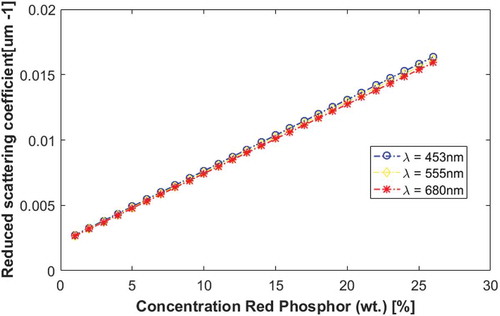
Figure 5. Anisotropy coefficient of the red-emitting phosphor Ba2Si5N8Eu2+ with wavelengths of 453, 555, and 680 nm.
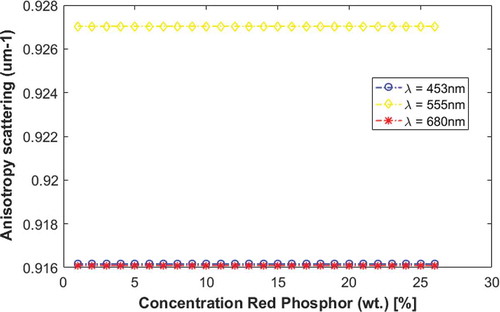
Figure 6. Scattering amplitude of the red-emitting phosphor Ba2Si5N8Eu2+ with wavelengths of 453, 555, and 680 nm.
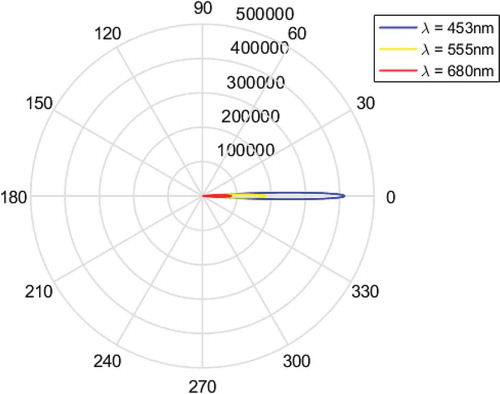
In this segment, the D-CCT, CRI, CQS, and the lumen output of the 7,700 K and 7,000 K MCW-LEDs are calculated and obtained by using the commercial software Light Tools. In this simulation, the concentration of the red-emitting Ba2Si5N8Eu2+ phosphor varied continuously from 0% to 0.4%. From the simulation results, the corresponding values of D-CCT are calculated and are indicated in Figure . As shown in Figure , the D-CCT had a slight decrease when the concentration of the red-emitting Ba2Si5N8Eu2+ phosphor varied from 0% to 0.26%. Then, the D-CCT of the MCW-LEDs increased while the red-emitting Ba2Si5N8Eu2+ phosphor changed to 0.4%. The most interesting aspect of this graph is the lowest value of the D-CCT is obtained at 0.16–0.26% concentration of the red-emitting Ba2Si5N8Eu2+ phosphor. Moreover, Figures and show the CQS and CRI of the in-cup packaging MCW-LEDs while the concentration of the red phosphor changed from 0% to 0.4%. It can be indicated that the CQS and CRI grow with the concentration red phosphor in the range from 0% to nearly 0.26%. The highest CQS and CRI is obtained with the red weight varying from 0.24% to 0.26%. As shown in Figures and , the CQS and CRI could obtain the highest value near 70 and 85, respectively. Likewise, the influence of the red-emitting Ba2Si5N8Eu2+ phosphor’s concentration on the luminous efficacy of the fin-cup packaging MCW-LEDs is shown in Figure . The results showed that the lumen output had a considerable decrease while the concentration of the red-emitting phosphor varied from 0.1% to 0.4%. This point of view means that the red-emitting Ba2Si5N8Eu2+ phosphor had a harmful impact on the luminous efficacy because of the highly reduced scattering of the blue light in the phosphor compound. It is linked to the loss of the energy of the white light. From that point of view, the CQS, CRI, and D-CCT of high CCT MCW-LEDs can be controlled by adding red-emitting phosphor in phosphor compound and varying its concentration. The best value of the D-CCT, CRI, and CQS can be obtained when the concentration of the red-emitting Ba2Si5N8Eu2+ phosphor is nearly 0.24–0.26%.
4. Conclusion
The purpose of this paper is to determine the influence of the red-emitting Ba2Si5N8Eu2+ conversion phosphor concentration on the optical performance of the 7,000 K and 7,700 K in-cup packaging MCW-LEDs. The results of this investigation show that the concentration of the red phosphor particles crucially influenced the optical performance of the in-cup packaging MCW-LEDs. D-CCT, CRI, and CQS can obtain the best value at the 0.24–0.26% concentration of the red-emitting Ca2Si5N8Eu2+ phosphor. Further studies need to be carried out to validate the influence of the red-emitting Ba2Si5N8Eu2+ phosphor size on the optical performance of the in-cup packaging MCW-LEDs.
Acknowledgement
The authors appreciate the support of Professor Hsiao-Yi Lee, Department of Electrical Engineering, National Kaohsiung University of Applied Sciences, Kaohsiung City, Taiwan.
Additional information
Funding
Notes on contributors
Phu Tran Tin
Phu Tran Tin received bachelor’s and master’s degree from Ho Chi Minh City University of Science. He is a lecturer at the Faculty of Electronics Technology, Industrial University of Ho Chi Minh City.
Nguyen Huu Khanh Nhan
Nguyen Huu Khanh Nhan obtained his Ph.D. from the Institute of Research and Experiments for Electrical and Electronic Equipment, Moscow. He serves as lecturer in the Faculty of Electrical and Electronics Engineering, Ton Duc Thang University, Ho Chi Minh City, Vietnam.
Tran Hoang Quang Minh
Tran Hoang Quang Minh received his Ph.D. from Tomsk Polytechnic University, Tomsk, Russian Federation. He serves as lecturer in the Faculty of Electrical and Electronics Engineering, Ton Duc Thang University, Ho Chi Minh City, Vietnam.
Nguyen Thi Phuong Thao
Nguyen Thi Phuong Thao is teaching at the Department of Electrical and Electronics Engineering, Ton Duc Thang University, Ho Chi Minh City, Vietnam.
References
- Anh, N. , Quoc, D. , & Lee, H.-Y. (2016). Improving the angular color uniformity and the lumen output for multi-chip white LED lamps by green Ce0.67Tb0.33MgAl11O19: Ce, Tb phosphor. Journal of the Chinese Institute of Engineers , 39(7), 871–875. doi:10.1080/02533839.2016.1208062
- Anh, N. D. Q. , Lee, H.-Y. , Phuong, T. T. , Nhan, N. H. K. , Minh, T. H. Q. , & Ly, T. H. (2017). Y2O3:Eu3 phosphor: A novel solution for an increase in color rendering index of multi-chip white LED packages. Journal of the Chinese Institute of Engineers , 40(3), 228–234. doi:10.1080/02533839.2017.1299592
- Beyond Mie’s theory II - The generalized mie theory . (2011). In Optical properties of nanoparticle systems (pp. 317–339). doi:10.1002/9783527633135.ch10
- Chen, C. , & Xie, E. (2014). Synthesis and luminescence properties of red-emitting M2Si5N8: Eu2-based (M=Ca, Sr, Ba) phosphors by a simple nitrate reduction. Science China Physics, Mechanics and Astronomy , 57(3), 433–436. doi:10.1007/s11433-013-5204-4
- Design of LED packaging applications . (2011). In LED packaging for lighting applications (pp. 215–315). doi:10.1002/9780470827857.ch6
- Duan, C. J. , Otten, W. M. , Delsing, A. C. A. , & Hintzen, H. T. (2008). Preparation and photoluminescence properties of Mn2+-activated M2Si5N8 (M=Ca, Sr, Ba) phosphors. Journal of Solid State Chemistry , 181(4), 751–757. doi:10.1016/j.jssc.2007.12.031
- Frisvad, J. R. , Christensen, N. J. , & Jensen, H. W. (2012). Predicting the appearance of materials using Lorenz–Mie theory. In The Mie theory Springer series in optical sciences (pp. 101–133). doi:10.1007/978-3-642-28738-1_4
- Fukuda, Y. , Okada, A. , & Albessard, A. K. (2012). Luminescence properties of Eu2+ doped red-emitting Sr-containing Sialon phosphor. Applied Physics Express , 5(6), 062102. doi:10.1143/apex.5.062102
- Gibney, E. (2014). Nobel for blue LED that revolutionized lighting. Nature , 514(7521), 152–153. doi:10.1038/514152a
- Hu, R. , Luo, X. , & Liu, S. (2011). Effect of the amount of phosphor silicone gel on optical property of white light-emitting diodes packaging. In 2011 12th international conference on electronic packaging technology and high density packaging . doi:10.1109/icept.2011.6067015
- Jonasz, M. , & Fournier, G. R. (2007). General features of scattering of light by particles in water. In Light scattering by particles in water (pp. 87–143). doi:10.1016/b978-012388751-1/50003-x
- Li, H.-L. , Xie, R.-J. , Hirosaki, N. , Takeda, T. , & Zhou, G.-H. (2009). Synthesis and luminescence properties of orange-red-emitting M2Si5N8: Eu2(M=Ca, Sr, Ba) light-emitting diode conversion phosphors by a simple nitridation of MSi2. International Journal of Applied Ceramic Technology , 6(4), 459–464. doi:10.1111/j.1744-7402.2009.02370.x
- Li, S. , Wang, K. , Chen, F. , Zhao, S. , Zhao, Z. , & Liu, S. (2012). Angular color uniformity enhancement of phosphor converted white LEDs integrated with compact modified freeform TIR components. In 2012 13th international conference on electronic packaging technology & high density packaging . doi:10.1109/icept-hdp.2012.6474888
- Li, Y. Q. , Van Steen, J. E. J. , Van Krevel, J. W. H. , Botty, G. , Delsing, A. C. A. , Disalvo, F. J. , … Hintzen, H. T. (2006). Luminescence properties of red-emitting M2Si5N8: Eu2(M: Ca, Sr, Ba) LED conversion phosphors. ChemInform , 37(36). doi:10.1002/chin.200636013
- Liu, Z. , Liu, S. , Wang, K. , & Luo, X. (2008a). Analysis of factors affecting color distribution of white LEDs. In 2008 International conference on electronic packaging technology & high density packaging . doi:10.1109/icept.2008.4607013
- Liu, Z. , Liu, S. , Wang, K. , & Luo, X. (2008b). Optical analysis of color distribution in white LEDs with various packaging methods. IEEE Photonics Technology Letters , 20(24), 2027–2029. doi:10.1109/lpt.2008.2005998
- Liu, Z. , Liu, S. , Wang, K. , & Luo, X. (2008c). Effects of phosphor’s location on LED packaging performance. In 2008 International conference on electronic packaging technology & high density packaging . doi:10.1109/icept.2008.4606982
- Luo, X. , & Hu, R. (2014). Chip packaging: Encapsulation of nitride LEDs. In Nitride semiconductor Light-Emitting Diodes (LEDs) (pp. 441–481). doi:10.1533/9780857099303.2.441
- Luo, X. , Hu, R. , Liu, S. , & Wang, K. (2016). Heat and fluid flow in high-power LED packaging and applications. Progress in Energy and Combustion Science , 56, 1–32. doi:10.1016/j.pecs.2016.05.003
- Mackowski, D. (2012). The extension of Mie theory to multiple spheres. In The Mie theory Springer series in optical sciences (pp. 223–256). doi:10.1007/978-3-642-28738-1_8
- Minh, T. , Quang, H. , Nhan, N. H. K. , Anh, N. D. Q. , & Lee, H.-Y. (2017). Red-emitting α-SrO·3B2O3: Sm2 phosphor: An innovative application for increasing color quality and luminous flux of remote phosphor white LEDs. Journal of the Chinese Institute of Engineers , 40(4), 313–317. doi:10.1080/02533839.2017.1318720
- Mishchenko, M. I. , Travis, L. D. , & Lacis, A. A. (2002). Scattering, absorption, and emission of light by small particles . Cambridge: Cambridge University Press.
- Shuai, Y. , He, Y. , Tran, N. T. , & Shi, F. G. (2011). Angular CCT uniformity of phosphor-converted white LEDs: Effects of phosphor materials and packaging structures. IEEE Photonics Technology Letters , 23(3), 137–139. doi:10.1109/LPT.2010.2092759
- Sommer, C. , Frank Reil, J. R. , Krenn, P. H. , Pachler, P. , Hoschopf, H. , & Wenzl, F. P. (2011). The impact of light scattering on the radiant flux of phosphor-converted high power white light-emitting diodes. Journal of Lightwave Technology , 29(15), 2285–2291. doi:10.1109/jlt.2011.2158987
- Sommer, C. , Wenzl, F.-P. , Hartmann, P. , Pachler, P. , Schweighart, M. , Tasch, S. , & Leising, G. (2008). Tailoring of the color conversion elements in phosphor-converted high-power LEDs by optical simulations. IEEE Photonics Technology Letters , 20(9), 739–741. doi:10.1109/lpt.2008.921063
- Tran, N. T. , & Shi, F. G. (2008). Studies of phosphor concentration and thickness for phosphor-based white light-emitting-diodes. Journal of Lightwave Technology , 26(21), 3556–3559. doi:10.1109/jlt.2008.917087
- Winkler, H. , Trinh, Q. , Bodrogi, P. , & Khanh, T. Q. (2015). LED lighting: Technology and perception . Weinheim: Wiley-VCH.
- Wriedt, T. (2012). Mie theory: A review. In The Mie theory Springer series in optical sciences (pp. 53–71). doi:10.1007/978-3-642-28738-1_2
- Zeuner, M. , Schmidt, P. J. , & Schnick, W. (2009). ChemInform abstract: One-pot synthesis of single-source precursors for nanocrystalline LED phosphors M2Si5N8: Eu2(M: Sr, Ba). ChemInform , 40(42). doi:10.1002/chin.200942207
- Zhong, J. , Xie, M. , Ou, Z. , Zhang, R. , Huang, M. , & Zhao, F. (2011). Mie theory simulation of the effect on light extraction by 2-D nanostructure fabrication. In 2011 Symposium on Photonics and Optoelectronics (SOPO) . doi:10.1109/sopo.2011.5780566

